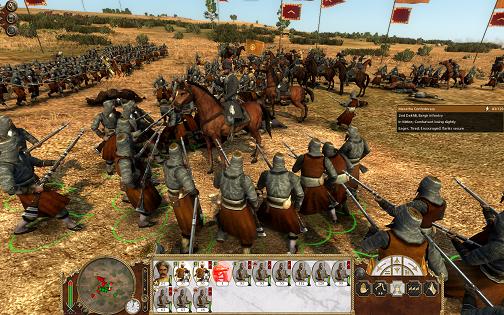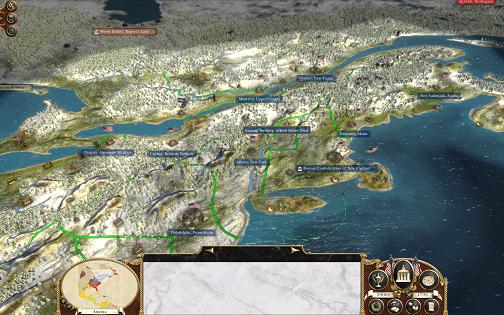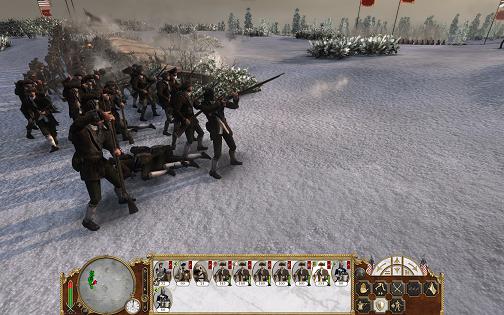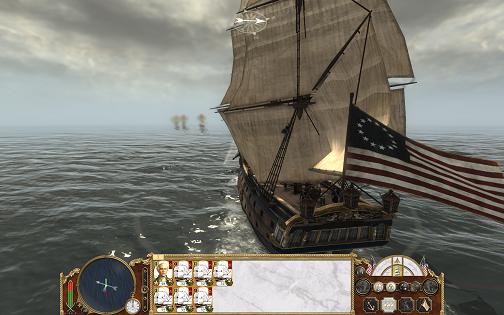
In a way, Empire is what Creative Assembly’s Total War series has always been building towards. Epic doesn’t even begin to describe its scope. Three distinct theatres, a dizzying multitude of major and minor factions, a greatly expanded strategic layer involving tech trees and multiple towns in each region, the ability to play naval battles in real-time mode for the first time and last but far from least, a spiffy new graphics engine so detailed and shiny that you can see the guns and buttons of your each of your soldiers gleaming in full HDR bloom.
Empire covers a relatively thin slice of history, but what glorious history it is! The French and American Revolutions, the rise of gunpowder and the apogee of the Age of Sail, the Age of Enlightenment and the beginnings of the globalized world. No one is ever going to mistake the Total War series as a replacement for a real history textbook, but this is as close as you’re going to get in a mass market video game. Total War fans already know the drill, but here it is anyway for those who have managed to miss out on it for the past 10 years.
The action is divided between a turn-based strategic layer and a real-time mode for battles. The strategic game is more than ever reminiscent of 4X games like Civilization, during which you build up your regions, produce and move your troops and conduct diplomacy. When two opposing armies meet on the strategic map, you switch to a battle phase that is not unlike a traditional RTS, except that you only have access to whatever troops you actually manage to bring with you to the fight.
This straightforward formula has been the key to the success and continued popularity of the series since its inception. The strategic map provides a grand canvas for an epic campaign set within a realistic historical context while the RTS mode gives you the satisfaction of personally directing your forces and seeing your thousands of toy soldiers in action. Decisions and outcomes in each mode feed into the other. Do well on the strategic map, and you’ll have the economic and productive might to bring down vast numbers of elite troops upon your foes. Succeed in the RTS mode and you may find that even smaller numbers may prevail against greater odds, thereby preserving resources and earning your troops valuable experience to bring to the next battle.

What’s new in Empire is that the grand canvas now stretches from the Americas in the west, through the entirety of Europe and parts of northern Africa to the Indian subcontinent in the east. Between these three theatres are the so-called trade theatres to represent the raw resources that you can extract from other parts of the world. Each of these theatres have a limited number of slots into the trading ships of each faction can park, simulating a frenzied rush for resources. The potential economic gains are mindblowing, but trading routes are vulnerable to raids and might even be blockaded entirely. To prevent things from getting out of hand, each region now represents a larger piece of terrain than previous games. The entirety of France, for example, is now one huge and immensely valuable region.
This is counterbalanced by another change: each region now holds, in addition to the region capital, multiple outlying towns and resource slots. Town slots can be specialized for various purposes, a religious building to convert a region to your native religion, say, or a weaver’s cottage to produce more taxable wealth. This means that if your forces aren’t strong enough to conquer a region capital, you can still harass the enemy by sacking his smaller towns and wealth producing resources.
Numerous other improvements help to streamline play further. Tax policies are now set on a theatre wide basis, though you can choose to exempt a particularly unruly region from taxes. Depleted armies can be replenished in the field without having to return to a city. Agents are no longer directly recruited but rather spawn automatically from the appropriate buildings and have been reduced to just three types: the priest, the gentleman and the rake. Diplomacy can be initiated at any time with any faction doing away with the need for the diplomat. The priest’s role is largely unchanged while the rake combines the functions of the previously available spy and assassin. The gentleman is useful for helping to speed research but may also be used to steal technology from rivals or, for some factions, to duel with a rival gentleman.
The new tech tree is similar to those of other 4X games. One cool innovation is that many of the researchable technologies apply to units already recruited, rather than merely unlocking new ones. For example, the standard line infantry is available from the beginning of the game, but research can enable you to outfit them with bayonets, making them far deadlier in melee and allow them to use more advanced tactics in battle, the ever useful fire by rank, for example, which makes it possible for almost continuous gunfire by alternating between ranks of reloading and shooting soldiers.

On the tactical level, the change of focus towards gunpowder-based units mixes up the familiar Total War dynamic a fair bit. Just about every unit is now capable of ranged attacks, so you’ll find yourself maneuvering to overlap multiple fields of fire on enemies. Since guns are direct fire, line of sight and cover also come into play. No more hiding archers behind pikemen, but cowering behind a low wall works wonders for the longevity of your troops. Cavalry is no longer quite the king of the battlefield as a good volley is enough to turn a brave frontal charge into a humiliating rout. The new artillery is spectacularly entertaining when it works. Giant mortars anyone? A pity about the accuracy however.
One side effect of this is that troops seem appreciably less differentiated than before. One rifle carrying unit is much the same as another, whatever its name or how colourful its clothes, and no one, not even a general, can survive a hail of bullets. But there’s no denying that battles are thrilling, spectacular affairs. One complaint I have is that fortresses and city walls are now next to pointless. Not only are they easily felled by artillery, but all types of infantry can effortlessly scale walls, making defending against sieges a losing proposition. This is exarcebated by the hilariously bad pathfinding. Your troops will take more time moving from one wall of a fortress to another than the enemy will in walking all the way from the edge of the map to your fortress.
The biggest back-of-the-box bullet point, the real-time naval battles, looks even more cinematic than the land battles. You can literally see cannons blasting the hulls of ships into splinters and sailors falling from the rigging into the churning sea. If you’re a fan of the great battleships of the Age of Sail, you’ll marvel at the obvious attention to detail and care towards historical fidelity. There are plenty of options to play with, including different formations and types of cannon shot, and it’s entertaining to learn how the wind affects your ships’ movement and adapt your plans accordingly. Still as pretty as it looks, it’s a lot less tactically rich than land battles, and you’ll mostly either end up doing the same things over and over again or just put your trust in the auto-resolve option.
All of this sounds awesome, and it is, except for one thing: CA can’t make an AI that can even fake a modicum of competence at the strategic game. Except at the very beginning of a campaign when the odds are heavily stacked against the player, the AI never feels like a significant threat. Instead of building up its forces into formidable stacks which it surely has the resources to do, given the blatant bonuses it gets, it has a habit of sending small raiding parties of one or two units. In one game as the Maratha Confederacy in India, the AI predictably sent a single unit into my territory from a fixed direction every turn for nearly a decade until I got fed up and conquered the city they were coming from.

As the developers have recently admitted, the AI is also at the present time utterly incapable of mounting a naval invasion. This is a game-breaking bug because it means that some provinces never need to be defended because you know that the AI will never be able to attack it. This isn’t to say that there’s no challenge at all on the strategic level. It is still possible for the player to expand too quickly and be overwhelmed, but as it’s entirely up to player how quickly he wants to expand, it ends up feeling a bit like playing solitaire. You’re sitting down at this huge, shiny and deliciously complicated game board and you realize that you’re the only player present who’s playing to win.
Happily, the AI on the tactical level is noticeably better than that in previous games. Position your general too near to the front, even if you have a unit screening it, and the AI might try to make a beeline for him with its strongest troops. It’s also clever enough to constantly try to flank you with cavalry and is especially eager to take down vulnerable looking artillery units. Too bad the strategic AI can’t consistently field large and well constructed armies for the tactical AI to use.
Apart from the AI, there are plenty of other reasons to feel less than satisfied with the game. How about the embarrassingly thin and incomplete manual? Or the lack of in-game feedback on how your decisions on strategic map actually affect things? Why are the description fields of units, technologies and buildings filled with historical flavour text rather than detailed descriptions of in-game effects? Why is the interface so unresponsive in an age when dual and even quad core processors are the norm? Why is there still no attempt to add such elementary UI functions as putting a unit into sleep or sentry mode and skipping to the next unit with available movement? For a game that is so obviously copying elements from Civilization, it has a lot to learn from that series about presenting information in such a way that the player is able to make educated decisions quickly and efficiently.
All of this means that Empire is the first Total War game I’ve felt really disappointed in, if only because CA has flubbed so many previous opportunies to truly refine their game. It’s clear that CA is more interested in adding ever more shiny stuff and exciting features with every new iteration of the series than crafting a coherent game in which all of the mechanics hang together perfectly. As it is the tutorial Road to Independence mini-campaign depicting the founding of America was more interesting to me than the actual full campaign as it led the player through a set of tightly scripted challenges. The grand campaigns felt suitably grand and rife with possibilities at first, but ended up being boring. Given time, modders and patches will probably make the final product into something that’s actually worth playing, but for now, apart for fans who are into the multi-player scene and can safely ignore the AI issues, this is one game that I’ll have to tell people to pass on.

I think it is a fair review(altough I disagree with the conclusion:P). Empire is the MOST work in progress Total War. However, I still think its the best one yet. The tactical battles are amazing.
I just have to point out that the grand campaign may have some balance issues as I too have played the Marathas and their campaign quickly becomes boring after defeating the Mughals. I literally reached my objectives by 1750. Playing smaller nations might be a more fun experience.
Despite the seemingly generic units, there is some differences between factions and the units. The marathas line infantry(Bargir infantry) are not that good melee compared to their western counterpart(you will learn this once you meet the Russians, if you so choose). But if you look at the strength of the Indian army(powerful melee units) you will find that the effective way to use them is different from the popular thin red line British strategy. The use of melee units can be key for the poor gun powder units. I agree about the lack of documentation but what I find amazing is that I’m still learning new things/tactics and strategies for this game even now. I’m still clueless on how to use Dragoon effectively(and experimenting with ways of deploying them to maximum effect).
The tactical AI has surprised me even now. Sometimes I feel some of the cavalry units have some sort of invisible special power that allows them to sneak past my army and attack from the rear. Strategic AI has always been CA’s weakness but at least I’m seeing that they are trying their best to improve it.
I know many people who think the entire Total War series as being great in the beginning but boring later on but I also know a lot people that constantly try new things and discover new things in these games.
The next patch is a major gameplay update that will have a lot of balance changes and better naval AI and pathfinding. I personally think Total War fans must get Empire. Especially after they release the next few patches.
Good review by the way. Well written and presented.
Whoa, very extensive and detailed comments. Thanks very much for that. Your comments are true, but don’t really invalidate my points I think. The strategic AI remains fairly terrible and unless it gets fixed, it doesn’t make for a very good single player experience after the initial stages of the campaign. I’ve also agreed that the tactical phase is excellent but without a good strategic AI backing it up, that’s just meaningless.
Generally I still feel that CA likes to add tons of new features and stuff but doesn’t take the time to polish and refine their games. I was willing to forgive it so far because they’ve been doing something no one else is doing, but it’s a mature franchise by now, and they should be held to higher standards.
Yes it is a tad bit disappointing especially after they talked it up about the diplomacy AI being unified with the tactical AI etc. In some cases I think I don’t see the Allies stabbing you in the back syndrome any longer which is good. But the strategic competency of the AI is still weak I agree.
Well if you look at the bright side. At least now with the code rework, they have the code base to improve what could be a great AI in the future. I’d be interested to see the mod tools they will be releasing…can’t wait…South East Asia Total War!
Just one question i was pretty sure when i first got the game the Bagir infanty could fire by rank was this true?? or did i imagine that after getting the upgrades we got new cool units but lost certain abilities???
You would do better by asking someone who actively plays the game more, this guy for instance:
http://malaysian-gamer.blogspot.com/
But I believe that fire by rank was removed from the Maratha in a patch. I can’t say for sure however.